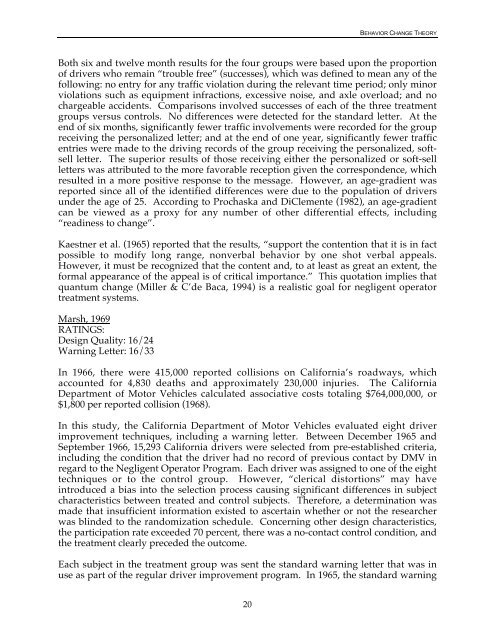Application of Behavior Change Theory to the Development
Application of Behavior Change Theory to the Development
Application of Behavior Change Theory to the Development
Create successful ePaper yourself
Turn your PDF publications into a flip-book with our unique Google optimized e-Paper software.
20<br />
BEHAVIOR CHANGE THEORY<br />
Both six and twelve month results for <strong>the</strong> four groups were based upon <strong>the</strong> proportion<br />
<strong>of</strong> drivers who remain “trouble free” (successes), which was defined <strong>to</strong> mean any <strong>of</strong> <strong>the</strong><br />
following: no entry for any traffic violation during <strong>the</strong> relevant time period; only minor<br />
violations such as equipment infractions, excessive noise, and axle overload; and no<br />
chargeable accidents. Comparisons involved successes <strong>of</strong> each <strong>of</strong> <strong>the</strong> three treatment<br />
groups versus controls. No differences were detected for <strong>the</strong> standard letter. At <strong>the</strong><br />
end <strong>of</strong> six months, significantly fewer traffic involvements were recorded for <strong>the</strong> group<br />
receiving <strong>the</strong> personalized letter; and at <strong>the</strong> end <strong>of</strong> one year, significantly fewer traffic<br />
entries were made <strong>to</strong> <strong>the</strong> driving records <strong>of</strong> <strong>the</strong> group receiving <strong>the</strong> personalized, s<strong>of</strong>tsell<br />
letter. The superior results <strong>of</strong> those receiving ei<strong>the</strong>r <strong>the</strong> personalized or s<strong>of</strong>t-sell<br />
letters was attributed <strong>to</strong> <strong>the</strong> more favorable reception given <strong>the</strong> correspondence, which<br />
resulted in a more positive response <strong>to</strong> <strong>the</strong> message. However, an age-gradient was<br />
reported since all <strong>of</strong> <strong>the</strong> identified differences were due <strong>to</strong> <strong>the</strong> population <strong>of</strong> drivers<br />
under <strong>the</strong> age <strong>of</strong> 25. According <strong>to</strong> Prochaska and DiClemente (1982), an age-gradient<br />
can be viewed as a proxy for any number <strong>of</strong> o<strong>the</strong>r differential effects, including<br />
“readiness <strong>to</strong> change”.<br />
Kaestner et al. (1965) reported that <strong>the</strong> results, “support <strong>the</strong> contention that it is in fact<br />
possible <strong>to</strong> modify long range, nonverbal behavior by one shot verbal appeals.<br />
However, it must be recognized that <strong>the</strong> content and, <strong>to</strong> at least as great an extent, <strong>the</strong><br />
formal appearance <strong>of</strong> <strong>the</strong> appeal is <strong>of</strong> critical importance.” This quotation implies that<br />
quantum change (Miller & C’de Baca, 1994) is a realistic goal for negligent opera<strong>to</strong>r<br />
treatment systems.<br />
Marsh, 1969<br />
RATINGS:<br />
Design Quality: 16/24<br />
Warning Letter: 16/33<br />
In 1966, <strong>the</strong>re were 415,000 reported collisions on California’s roadways, which<br />
accounted for 4,830 deaths and approximately 230,000 injuries. The California<br />
Department <strong>of</strong> Mo<strong>to</strong>r Vehicles calculated associative costs <strong>to</strong>taling $764,000,000, or<br />
$1,800 per reported collision (1968).<br />
In this study, <strong>the</strong> California Department <strong>of</strong> Mo<strong>to</strong>r Vehicles evaluated eight driver<br />
improvement techniques, including a warning letter. Between December 1965 and<br />
September 1966, 15,293 California drivers were selected from pre-established criteria,<br />
including <strong>the</strong> condition that <strong>the</strong> driver had no record <strong>of</strong> previous contact by DMV in<br />
regard <strong>to</strong> <strong>the</strong> Negligent Opera<strong>to</strong>r Program. Each driver was assigned <strong>to</strong> one <strong>of</strong> <strong>the</strong> eight<br />
techniques or <strong>to</strong> <strong>the</strong> control group. However, “clerical dis<strong>to</strong>rtions” may have<br />
introduced a bias in<strong>to</strong> <strong>the</strong> selection process causing significant differences in subject<br />
characteristics between treated and control subjects. Therefore, a determination was<br />
made that insufficient information existed <strong>to</strong> ascertain whe<strong>the</strong>r or not <strong>the</strong> researcher<br />
was blinded <strong>to</strong> <strong>the</strong> randomization schedule. Concerning o<strong>the</strong>r design characteristics,<br />
<strong>the</strong> participation rate exceeded 70 percent, <strong>the</strong>re was a no-contact control condition, and<br />
<strong>the</strong> treatment clearly preceded <strong>the</strong> outcome.<br />
Each subject in <strong>the</strong> treatment group was sent <strong>the</strong> standard warning letter that was in<br />
use as part <strong>of</strong> <strong>the</strong> regular driver improvement program. In 1965, <strong>the</strong> standard warning
















